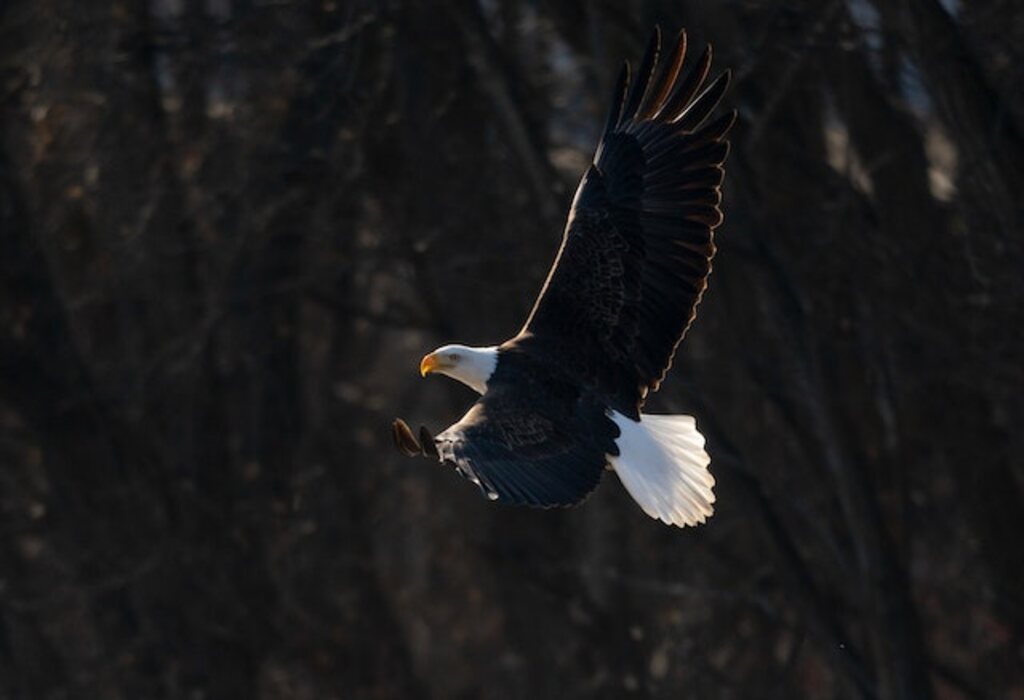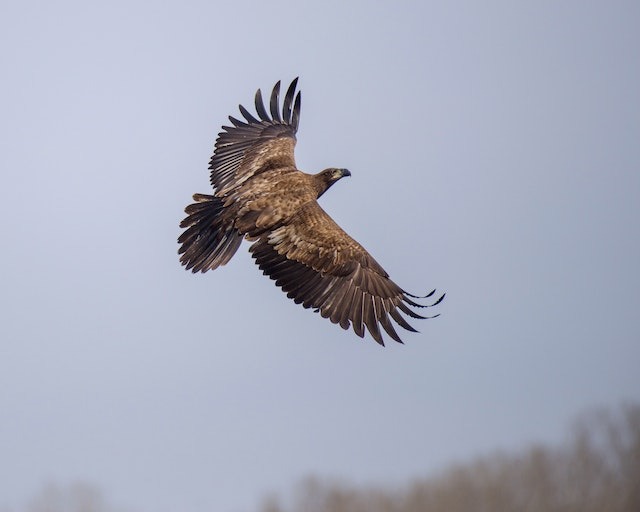In the vast expanse of the sky, where freedom knows no bounds, there exists a majestic creature capable of defying gravity and ascending to unimaginable heights. The eagle, renowned for its awe-inspiring flight abilities, has captivated the human imagination for centuries.
With its keen eyesight, powerful wings, and remarkable adaptations, the eagle soars effortlessly through the heavens, navigating the invisible currents of air with unparalleled grace. But just how high can this regal avian ascend?
This article delves into the scientific exploration of eagle flight, examining the factors that influence their altitude capabilities and shedding light on the astonishing records achieved by these magnificent birds.
Through a comprehensive understanding of their adaptations and the challenges they face, we can gain a deeper appreciation for the eagle’s mastery of the skies and the importance of conserving their natural habitats.
So join us on this scientific journey as we unravel the mysteries of how high an eagle can truly fly.
Table of Contents
- 1 Key Takeaways
- 2 How High Can An Eagle Fly
- 3 The Flight Abilities of Eagles
- 4 Factors Affecting Eagle Flight
- 5 But How High Can Eagles Really Fly?
- 6 The Altitude Records of Eagles
- 7 Eagle Species with Impressive Altitudes
- 8 The Purpose of High-Flying Behavior
- 9 Adaptations for High-Altitude Flight
- 10 Challenges and Risks of High-Altitude Flight
- 11 Conservation Efforts for Eagles
- 12 Appreciating the Majesty of Eagle Flight
- 13 Frequently Asked Questions
- 14 Conclusion
- 15 Author
Key Takeaways
- Eagles can fly at altitudes of up to 15,000 feet, with some species reaching even higher elevations.
- Eagles can conserve energy by catching thermal updrafts and riding on warm air currents.
- Eagles have keen eyesight and acute sense of hearing, which help them navigate and locate prey from great distances.
- Climate change can impact eagle migration patterns and altitudes, potentially affecting their ability to fly at high altitudes.

How High Can An Eagle Fly
Eagles showcase an exceptional ability to soar at altitudes up to 15,000 feet, with some species reaching even higher elevations. This remarkable feat is attributed to their powerful wings, keen eyesight, and utilization of thermal updrafts.
By leveraging these factors, eagles effortlessly navigate the skies, allowing them to survey extensive territories, spot prey, and exhibit their prowess as magnificent aerial predators.
The Flight Abilities of Eagles
The flight abilities of eagles are remarkable, allowing them to soar to impressive heights in the sky.
Eagles have the ability to fly at altitudes of up to 15,000 feet, although some species are known to reach even higher elevations. This remarkable feat is made possible by several factors.
Firstly, eagles have powerful wings with a large wingspan, which enables them to catch thermal updrafts and ride on the currents of warm air. This allows them to conserve energy while flying at high altitudes.
Additionally, their keen eyesight and acute sense of hearing help them navigate and locate prey from great distances.
Furthermore, eagle migration patterns also play a role in their ability to fly at high altitudes.
These majestic birds are known to undertake long-distance migrations, which require them to fly at high altitudes to avoid obstacles and adverse weather conditions.
Understanding the factors affecting eagle flight is crucial in appreciating the incredible heights these birds can reach.
Factors Affecting Eagle Flight
Factors such as atmospheric conditions and wing morphology significantly influence the potential altitude achieved by these majestic birds of prey. The ability of eagles to fly at high altitudes is affected by several factors.
Firstly, the atmospheric conditions play a crucial role in determining the maximum altitude an eagle can reach. High altitude winds, temperature variations, and air density affect the bird’s ability to sustain flight.
Secondly, the wing morphology of eagles is adapted to their flight requirements. Longer wings and broad wingtips enable them to soar effortlessly and gain altitude.
Lastly, factors affecting migration and thermoregulation strategies also impact the altitude eagles can attain. Migration patterns and seasonal changes influence the availability of thermals and updrafts that aid in their flight.
Understanding these factors is essential to comprehending how high eagles can fly and the mechanisms behind their impressive aerial capabilities.
But How High Can Eagles Really Fly?
Altitude achieved by eagles is influenced by atmospheric conditions and wing morphology. Several factors affect the altitude at which eagles can fly.
Firstly, atmospheric conditions such as temperature, air density, and wind speed play a crucial role. Eagles need sufficient lift to gain altitude, and this is affected by the density of the air.
Secondly, wing morphology, including wing length and shape, determines the efficiency of flight. Eagles have long, broad wings that allow for gliding and soaring, enabling them to reach higher altitudes.
In comparison with other birds, eagles have the ability to fly at greater heights due to their unique combination of physiological and morphological adaptations.
Understanding these factors is essential to comprehend the altitude records of eagles, which will be discussed in the subsequent section.

The Altitude Records of Eagles
Eagles have soared to heights comparable to a mountaintop, defying gravity with their exceptional flight capabilities.
These majestic birds have been observed flying at astounding altitudes during their migration, reaching heights of up to 10,000 feet above sea level.
However, it is important to note that the altitude records of eagles can vary depending on the species and individual characteristics.
Climate change has also been found to have an impact on eagle migration patterns and altitudes.
As the climate continues to change, it may affect the availability of food sources and alter the timing of migration, potentially influencing the altitudes at which eagles fly.
Understanding the altitude records of different eagle species with impressive altitudes will provide further insights into their adaptability and response to changing environmental conditions.
Eagle Species with Impressive Altitudes
One noteworthy aspect of the flight capabilities of these majestic birds lies in the impressive altitudes achieved by certain species.
The Golden Eagle is known to soar to great heights, with recorded flights up to 10,000 feet above sea level.
Another eagle species, the Steppe Eagle, has been observed flying at altitudes of up to 16,000 feet.
These impressive altitudes are made possible by the eagles’ exceptional flight abilities, including their powerful wings and keen eyesight.
The ability to fly at such heights allows eagles to survey vast territories, locate prey, and avoid potential threats.
Understanding the purpose of high-flying behavior in eagles provides valuable insights into their ecology and survival strategies.
The Purpose of High-Flying Behavior
The soaring heights achieved by certain eagle species provide valuable insights into their ecological strategies, allowing them to survey vast territories and swiftly evade potential threats.
High-flying behavior offers several benefits to eagles, conferring them with an evolutionary advantage over other avian species.
The ability to ascend to great altitudes enables eagles to gain a broader perspective of their surroundings, facilitating efficient surveillance of prey populations and potential competitors.
Additionally, flying at high altitudes grants eagles the advantage of decreased competition for resources, as fewer species are adapted to survive in such extreme conditions.
Furthermore, the reduced presence of predators at higher elevations decreases the risk of predation, enhancing the survival chances of these majestic birds.
Transitioning into the subsequent section about ‘adaptations for high-altitude flight’, eagles have evolved remarkable physiological and anatomical features to support their ability to soar at such heights.

Adaptations for High-Altitude Flight
High-altitude flight requires specific adaptations in order to survive and thrive in such extreme conditions.
One important adaptation is the development of powerful wings and muscles, which allow birds to generate enough lift and propulsion to fly efficiently at high altitudes.
Additionally, birds that engage in high-altitude flight have evolved an efficient respiratory system, enabling them to extract oxygen from the thin air found at high altitudes.
Finally, acute vision and hearing are crucial adaptations for high-altitude flight, as they allow birds to navigate and locate prey in vast and often inhospitable environments.
Powerful Wings and Muscles
With their formidable wings and robust muscles, eagles possess the physical capacity to soar to impressive heights.
Their flight mechanics and the aerodynamics of soaring allow them to take advantage of the wind currents and effortlessly glide through the air.
The wings of an eagle are long and broad, providing a large surface area for lift generation.
This, combined with their powerful flight muscles, enables them to generate enough thrust to overcome gravity and ascend to great heights.
Additionally, eagles have strong pectoral muscles that allow them to flap their wings with great force when needed.
This helps them maintain stability and control during flight. The table below provides a visual representation of the adaptations that contribute to the eagle’s ability to fly at high altitudes.
| Adaptation | Description |
|---|---|
| Long wings | Provides a large surface area for lift generation |
| Powerful muscles | Enables the generation of enough thrust to overcome gravity |
| Strong pectoral muscles | Allows for forceful wing flapping for stability and control during flight |
These adaptations work together to allow eagles to fly at great heights with ease. Moving on to the next section, eagles also have an efficient respiratory system that further facilitates their high-altitude flight.
Efficient Respiratory System
An additional adaptation that contributes to the impressive flight capabilities of eagles is their efficient respiratory system.
This system allows eagles to take in and process oxygen effectively, providing them with the necessary energy for sustained flight at high altitudes.
Eagles have large lungs and air sacs that enable them to inhale and exhale efficiently.
Additionally, their respiratory system is equipped with a complex network of air capillaries that maximize the exchange of oxygen and carbon dioxide.
This efficient respiration ensures that eagles can maintain a steady supply of oxygen to their muscles, allowing them to fly for extended periods without tiring.
Furthermore, the increased oxygen intake also supports their high metabolism, enabling them to hunt and capture prey while in flight.
This efficient respiratory system is just one of the many remarkable adaptations that contribute to the overall flying prowess of eagles.
Transitioning into the subsequent section about ‘acute vision and hearing,’ eagles’ exceptional respiratory system is complemented by their extraordinary sensory capabilities.
Acute Vision and Hearing
Eagles possess remarkable sensory abilities that enable them to excel in their high-altitude flight. One of their key attributes is their acute vision.
With eyesight four to eight times stronger than that of humans, eagles can spot prey from great distances, even while soaring at high altitudes.
Their eyes are equipped with a high concentration of light-sensitive cells called cones, allowing them to perceive a wide range of colors and detect even the slightest movements.
Additionally, eagles have exceptional hearing abilities. They can detect sounds from several miles away and accurately determine their direction.
This acute sense of hearing helps them locate potential prey or avoid potential threats.
These highly developed sensory capabilities contribute to the eagle’s success in navigating the challenges and risks of high-altitude flight.
Without a doubt, these adaptations are crucial for their survival in the skies.

Challenges and Risks of High-Altitude Flight
At extreme altitudes, the challenges and risks of flight become exponentially more treacherous, as the air thins to a near-imperceptible state and temperature drops to bone-chilling levels.
Eagles, renowned for their high-altitude flights, face a unique set of challenges and risks in these harsh conditions.
The scarcity of oxygen at high altitudes makes it difficult for the birds to breathe and maintain their metabolic needs.
Additionally, the low temperatures pose a risk of hypothermia, as the birds’ bodies are not adapted to withstand such extreme cold.
Strong winds and unpredictable weather patterns further complicate their flight, making it challenging to navigate and maintain stability.
Despite these challenges and risks, eagles have developed remarkable adaptations that allow them to thrive in high-altitude environments.
Transitioning into the subsequent section about conservation efforts for eagles, it is crucial to understand the importance of preserving their habitats and protecting them from further threats.
Conservation Efforts for Eagles
Conservation efforts for eagles encompass various strategies aimed at protecting their habitat, mitigating the threat of poaching, and implementing rehabilitation and release programs.
Habitat protection involves the preservation and restoration of suitable nesting areas, foraging grounds, and migratory routes.
Anti-poaching measures focus on enforcing laws and regulations to prevent the illegal capture, killing, and trade of eagles and their parts.
Additionally, rehabilitation and release programs aim to rescue injured or orphaned eagles, provide them with veterinary care and rehabilitation, and eventually release them back into the wild to ensure the continuity of their populations.
Habitat Protection
Protected habitats are crucial for the preservation of the eagle population and their ability to thrive. Habitat preservation plays a vital role in ensuring the long-term survival of these majestic birds.
Conservation strategies focused on habitat protection include the establishment of protected areas, such as national parks and wildlife reserves, where human activities are regulated to minimize disturbance to the eagles’ natural environment.
Additionally, habitat restoration efforts are undertaken to enhance degraded habitats and provide suitable nesting sites and food sources for eagles.
Collaborative initiatives involving governments, conservation organizations, and local communities aim to develop effective management plans to safeguard eagle habitats.
These efforts contribute to maintaining healthy ecosystems and ensuring the availability of vital resources for the eagles’ survival.
Transitioning into the subsequent section about ‘anti-poaching measures,’ it is essential to address the threat of illegal hunting and the need for stringent enforcement to combat this issue.
Anti-Poaching Measures
Enforcement efforts are crucial in countering the illegal hunting of eagles and ensuring their continued survival. Anti-poaching strategies play a significant role in protecting these majestic birds.
One effective approach is to involve local communities in conservation efforts. By engaging communities, poaching can be effectively prevented through increased surveillance and reporting of illegal activities.
Community members can act as watchdogs, monitoring and reporting any instances of eagle poaching.
Additionally, education programs can be implemented to raise awareness about the importance of eagle conservation and the consequences of poaching.
These initiatives not only help deter poachers but also foster a sense of ownership and responsibility among community members towards the protection of eagles.
Through community involvement and anti-poaching measures, the illegal hunting of eagles can be curbed, ensuring their survival for future generations.
Transitioning to the subsequent section on rehabilitation and release programs, these efforts contribute to the overall conservation of eagle populations.
Rehabilitation and Release Programs
Rehabilitation and release programs provide a lifeline for injured or orphaned eagles, offering them a second chance to spread their wings and soar towards a brighter future.
These programs employ a variety of rehabilitation techniques to restore the physical and mental health of the eagles.
Success stories abound, showcasing the effectiveness of these programs in rehabilitating eagles and reintroducing them into the wild.
Through meticulous care, injured eagles are nursed back to health, while orphaned eaglets are hand-reared until they are ready for release.
The rehabilitation process involves medical treatments, physical therapy, and behavioral training to ensure the eagles regain their natural instincts and abilities.
Once rehabilitated, the eagles are released into suitable habitats where they can thrive and contribute to the population.
Appreciating the majesty of eagle flight is a natural progression from understanding the efforts put into their rehabilitation.

Appreciating the Majesty of Eagle Flight
Majestically soaring through the sky, the eagle’s flight is a breathtaking spectacle that captivates observers with its grandeur and grace.
Appreciating eagle behavior and the beauty of eagle flight is essential to understanding and admiring these magnificent creatures.
Eagles are known for their powerful wingspan and remarkable aerial agility. They possess keen eyesight, allowing them to spot prey from high altitudes.
In addition to their physical prowess, eagles exhibit impressive flight techniques, such as soaring, gliding, and stooping.
Soaring allows them to conserve energy by riding thermal updrafts, while gliding enables them to cover vast distances.
Stooping, on the other hand, is a hunting technique where eagles dive rapidly towards their prey.
To truly appreciate the majesty of eagle flight, one must witness their seamless transitions between these flight patterns. The following table highlights the distinct flight techniques displayed by eagles:
| Flight Technique | Description |
|---|---|
| Soaring | Riding thermal updrafts |
| Gliding | Covering vast distances |
| Stooping | Rapid dive towards prey |
By studying and understanding these flight techniques, we can gain a deeper appreciation for the beauty and complexity of eagle flight.
Frequently Asked Questions
What is the average wingspan of an eagle?
The average wingspan of an eagle is approximately 6 to 7 feet. This physical adaptation enables eagles to soar through the air and efficiently navigate their surroundings. Their wingspan contributes to their impressive flight capabilities and hunting strategies.
How fast can eagles fly?
In the realm of avian capabilities, eagles are renowned for their impressive speed and soaring altitude. These majestic predators can reach speeds of up to 99 miles per hour while flying at elevations that exceed 10,000 feet.
Can eagles fly at night?
Eagles have excellent night vision, allowing them to fly and hunt during the night. Their hunting behavior at night involves silently gliding through the darkness, using their keen eyesight to spot prey.
Do eagles migrate to higher altitudes during certain seasons?
Eagle migration patterns are influenced by seasonal changes in food availability and breeding requirements. However, the impact of climate change on these patterns remains a topic of concern, as it may disrupt their traditional routes and timing.
Eagle navigation during high-altitude flights involves their ability to detect and utilize high altitude wind patterns. By leveraging these wind currents, eagles can efficiently navigate and maintain their desired flight paths without expending excessive energy.

Conclusion
In conclusion, the flight abilities of eagles are truly remarkable. They possess adaptations that allow them to soar to great heights, reaching altitudes that are awe-inspiring.
Factors such as wing size, air density, and weather conditions all play a role in determining the maximum height an eagle can reach.
Conservation efforts are crucial to ensure the continued existence of these majestic creatures and to protect their natural habitats.
Let us marvel at the majesty of eagle flight and appreciate the unique beauty they bring to our world.



